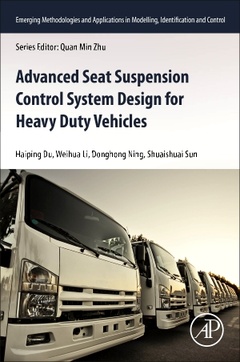Advanced Seat Suspension Control System Design for Heavy Duty Vehicles Emerging Methodologies and Applications in Modelling, Identification and Control Series
Auteurs : Du Haiping, Li Weihua, Ning Donghong, Sun Shuaishuai

Advanced Seat Suspension Control System Design for Heavy Duty Vehicles provides systematic knowledge of the advanced seat suspension design and control for heavy duty vehicles.
Nowadays, people are paying more and more attention to ride comfort and the health of drivers and passengers. This is especially for heavy duty vehicles, where drivers/operators are exposed to much severer vibrations than those in passenger vehicles due to a harsh working environment, operating conditions, and long hour driving, etc. Seat suspension systems can effectively help to suppress the high magnitude vibration transmitted to drivers with relatively simple structure and low cost, and hence are widely adopted in heavy duty vehicles.
This book helps researchers and engineers to have a comprehensive understanding of the seat suspension system and to conduct in-depth studies on seat suspension design and control; this book covers a wide range of perspectives about seat suspension design and control methods.
1. Introduction 2. Controllable electromagnetic damper-based seat suspension 3. Controllable magnetorheological fluid damper-based seat suspension 4. Self-powered MR seat suspension 5. Variable equivalent stiffness seat suspension 6. Variable equivalent inertance seat suspension 7. Single-DOF active seat suspension 8. Multiple-DOF active seat suspension 9. Active seat suspension control algorithm 10. Hybrid active and semi-active seat suspension 11. Nonlinear stiffness seat suspension
Appendix A. Vibration profile generation for seat suspension Appendix B. Simulation of seat suspension control Appendix C. Experimental setup
Index
Academia, Postgraduate students, Professional Engineers in Mechanical, Mechatronics, Mining, Automotive Engineering
Weihua Li received the B.E. and M.E. degrees in mechanical engineering from the University of Science and Technology of China, in 1992 and 1995, respectively, and the Ph.D. degree in mechanical engineering from the Nanyang Technological University, in 2001. He has been in the School of Mechanical, Materials and Mechatronic Engineering, University of Wollongong, Wollongong, N.S.W., Australia, as an Academic Staff Member, since 2003. He has published more than 260 technical articles in refereed international journals and conferences. Dr. Li serves as an Associate Editor or an Editorial Board Member for nine international journals. He received the number of awards, including the JSPS Invitation Fellowship in 2014, the Endeavour Research Fellowship in 2011, and the Scientific Visits to China Program Awards. Prof. Li co-supervised the whole research project on Advanced Seat Suspension Control System Design for Heavy Duty Vehicles.
Donghong Ning received the B.E. degree in agricultural mechanization and automation from the College of Mechanical and Electronic Engineering, North West Agriculture and Forestry University, Xianyang, China, in 2012. He obtained the Ph.D. degree from the School of Electrical, Computer and Telecommunications Engineering, University of Wollongong, Wollongong, N.S.W., Australia. He is currently working as an Associate Research Fellow at University of Wollongong. His research interests include seat suspension vibration control and multi degrees of freedom vibration control. Dr Ning did a relevant PhD research pro
- Describes the variable damping, variable stiffness, and, especially, variable inertance seat suspensions
- Provides the advanced and comprehensive knowledge about semi-active vibration control
- Introduces the multiple-DOF seat suspension
- Includes the innovative hybrid seat suspension and nonlinear seat suspension
- All the introduced designs have been prototyped and experimentally validated
- Provides Matlab Simulation programming codes
Date de parution : 05-2020
Ouvrage de 314 p.
15x22.8 cm
Thème d’Advanced Seat Suspension Control System Design for Heavy... :
Mots-clés :
active; active control; active seat suspension; electromagnetic; electromagnetic damper; heavy duty vehicles; hybrid seat suspension; inerter; low-frequency vibration; magnetic spring; magnetorheological fluid damper; MR damper; multiple-DOF; negative stiffness; ride comfort; rotary motor; rotary MR damper; seat suspension; seat suspension system; self-power; semi-active; semi-active control; sliding model control; TS fuzzy; variable damping; variable inertance; variable stiffness; vibration control; whole-body vibration



